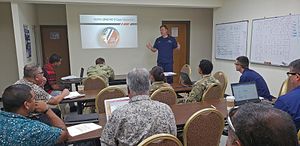The U.S. Coast Guard, under the aegis of Pacific Partnership 2019, concluded a three-day search and rescue exercise with the government of the Marshall Islands this weekend.
The U.S. Coast Guard’s 14th District sent coastguardsmen to Majuro in the Marshall Islands to begin the exercise. The U.S. Navy, U.S. army, and British Royal Navy sent servicemembers to the exercise and planning meeting as well.
The Pacific Partnership mission, carried out by the U.S. Navy and the Coast Guard, is the largest annual multilateral humanitarian assistance and disaster relief preparedness mission in the Asia-Pacific region.
“We have a close working relationship with the Marshall Islands and this planning meeting is a great opportunity for us to discuss any concerns and streamline our procedures to minimize casualties and maximize our ability to provide rescue assistance,” U.S. Coast Guard 14th District Joint Rescue Coordination Center Chief Lt. Cmdr. Kevin Cooper noted of the engagement.
“It is important when working with partner nations and several different government organizations that everyone is speaking the same language and adhering to similar policies and procedures to ensure mission capability and sustainability,” Royal Navy Capt. Paddy Allen, Pacific Partnership 2019 director of mission, said, according to U.S. Pacific Command.
The Trump administration has started to emphasize the South Pacific as part of its broader focus on the Indo-Pacific region amid concerns about China’s ambitions in the area.
“The Marshall Islands affirm our commitment to the U.S., partner nations and members of this mission,” Kalani Kaneko, the Minister of Health and Human Services for the Marshall Islands, said at the opening ceremony for Pacific Partnership 2019 in the country.
Earlier this month, senior director for Asian affairs on the White House National Security Council (NSC), Matt Pottinger, visited Vanuatu and the Solomon Islands on a broader trip to the region that also included stops in Australia, New Zealand, and Japan.
Pacific Partnership 2018 gave special focus to Southeast Asia, where it “put the spotlight on the evolution of U.S. drills in the region as part of its broader defense engagement,” as The Diplomat noted at the time.
The Pacific Partnership initiative began in the aftermath of the 2004 Indian Ocean tsunami, which caused massive damage across littoral South and Southeast Asia. The U.S. Navy played a major role in search and rescue and humanitarian assistance/disaster relief operations at the time.
The initiative is meant to allow U.S. personal to work “collectively with host and partner nations to enhance regional interoperability and disaster response capabilities, increase stability and security in the region, and foster new and enduring friendships in the Indo-Pacific,” according to a U.S. Pacific Command statement.

































